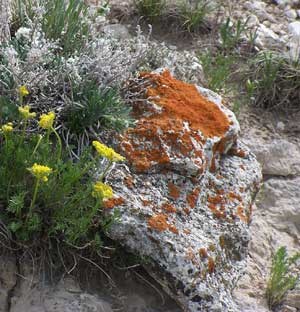
Lichen are extremely slow growing, only a few millimeters per year, but live for many years if undisturbed. Lichens are a good indicator of air quality due to their method of air exchange. Some lichen are sensitive to carbon dioxide, nitrogen oxides, fluorides or ozone, alone or in combination. The sensitivity of the lichens also varies with atmospheric conditions. When the plant is wet and active, it absorbs more air and pollutants and is affected faster than when it is dry and dormant. When damaged, lichen becomes discolored because of death of the algae causing bleached lobes followed by death of the algae. The lichen decomposes into the soil within a few months after its death. Because of the longevity of lichen, they indicate environmental factors over a long period of time. Chemical analysis of the plants can give indications of levels of toxic substances which accumulate in the plants. The lichens at Agate are generally healthy with a total of 64 species documented. Lichen grow on more than just rocks and at Agate, species of lichen are found on trees, rocks and soil. The wetland areas are densely covered with vascular plants with limited space available for lichen growth, but the thin soil on ridges provides habitat for soil lichens. The trees have several species of rare lichen that would not otherwise be found in a grassland. The most abundant locations for lichen are the rocks and rock outcroppings. Text by Kimberly Howard, Biological Science Technician, Agate Fossil Beds National Monument. |
Last updated: April 10, 2015
